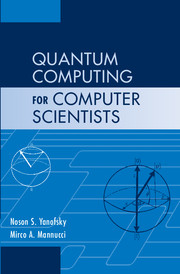Book contents
- Frontmatter
- Contents
- Preface
- Introduction
- 1 Complex Numbers
- 2 Complex Vector Spaces
- 3 The Leap from Classical to Quantum
- 4 Basic Quantum Theory
- 5 Architecture
- 6 Algorithms
- 7 Programming Languages
- 8 Theoretical Computer Science
- 9 Cryptography
- 10 Information Theory
- 11 Hardware
- Appendix A Historical Bibliography of Quantum Computing
- Appendix B Answers to Selected Exercises
- Appendix C Quantum Computing Experiments with MATLAB
- Appendix D Keeping Abreast of Quantum News: Quantum Computing on the Web and in the Literature
- Appendix E Selected Topics for Student Presentations
- Bibliography
- Index
1 - Complex Numbers
Published online by Cambridge University Press: 05 June 2012
- Frontmatter
- Contents
- Preface
- Introduction
- 1 Complex Numbers
- 2 Complex Vector Spaces
- 3 The Leap from Classical to Quantum
- 4 Basic Quantum Theory
- 5 Architecture
- 6 Algorithms
- 7 Programming Languages
- 8 Theoretical Computer Science
- 9 Cryptography
- 10 Information Theory
- 11 Hardware
- Appendix A Historical Bibliography of Quantum Computing
- Appendix B Answers to Selected Exercises
- Appendix C Quantum Computing Experiments with MATLAB
- Appendix D Keeping Abreast of Quantum News: Quantum Computing on the Web and in the Literature
- Appendix E Selected Topics for Student Presentations
- Bibliography
- Index
Summary
You, have you really understood all that stuff?
What?
The story of imaginary numbers?
Robert Musil, The Confusions of Young Törless (1907)Complex numbers lie at the very core of quantum mechanics and are therefore absolutely essential to a basic understanding of quantum computation. In this chapter we present this important system of numbers from both the algebraic and the geometric standpoints. Section 1.1 presents some motivation and the basic definitions. The algebraic structure and operations on complex numbers are given in Section 1.2. The chapter concludes with Section 1.3, where complex numbers are presented from a geometric point of view and advanced topics are discussed. Our hope is that this chapter will help you get a little closer to what Sir Roger Penrose has very aptly called the “magic of complex numbers” (Penrose, 2005).
Reader Tip. Many readers will find that they are already familiar with some of the material presented in this chapter. The reader who feels confident in her comprehension of the fundamental knowledge of complex numbers, the basic operations, and their properties can safely move on to later chapters. We suggest, though, that you at least skim through the following pages to see what topics are covered. Return to Chapter 1 as a reference when needed (using the index to find specific topics).
BASIC DEFINITIONS
The original motivation for the introduction of complex numbers was the theory of algebraic equations, the part of algebra that seeks solutions of polynomial equations.
Information
- Type
- Chapter
- Information
- Quantum Computing for Computer Scientists , pp. 7 - 28Publisher: Cambridge University PressPrint publication year: 2008
Accessibility standard: Unknown
Why this information is here
This section outlines the accessibility features of this content - including support for screen readers, full keyboard navigation and high-contrast display options. This may not be relevant for you.Accessibility Information
- 1
- Cited by
